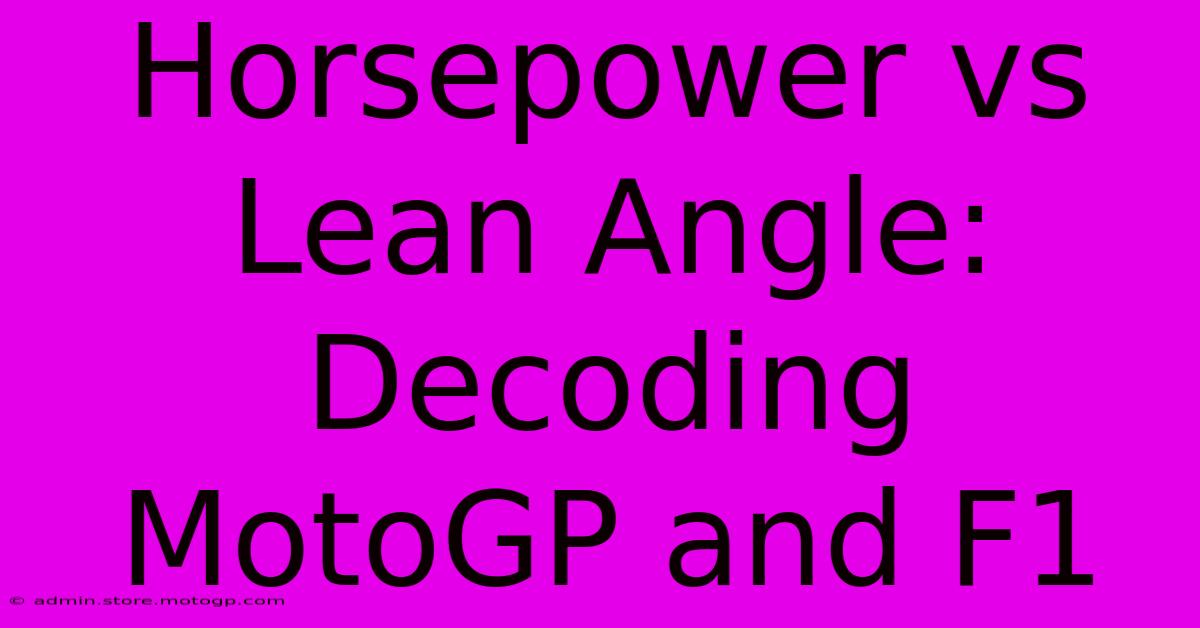Horsepower Vs Lean Angle: Decoding MotoGP And F1

Table of Contents
Horsepower vs Lean Angle: Decoding MotoGP and F1
The roar of engines, the screech of tires, the breathtaking speed – Formula 1 and MotoGP represent the pinnacle of motorsport. But while both feature incredibly fast machines pushing the boundaries of engineering, their approaches to achieving speed differ significantly. This article delves into the core differences between these two racing giants, focusing on the crucial factors of horsepower and lean angle.
The Power Play: Horsepower in F1 and MotoGP
Horsepower, the measure of an engine's power output, plays a starring role in both disciplines, but its significance varies considerably.
F1: Harnessing Aerodynamics and Downforce
Formula 1 cars boast incredibly powerful engines, typically exceeding 1000 horsepower. However, raw horsepower isn't the sole determinant of speed. F1 heavily emphasizes aerodynamics and downforce. These cars generate immense downforce, pressing them onto the track, allowing them to corner at incredibly high speeds, even without extreme lean angles. The focus is on maximizing grip through aerodynamic efficiency rather than solely relying on sheer power. The high horsepower is used to accelerate quickly out of corners and maintain high speeds on straights.
MotoGP: Lean, Mean, and Powerful
MotoGP bikes also pack a considerable punch, with engines producing over 260 horsepower. However, unlike F1 cars, MotoGP bikes rely heavily on lean angle to navigate corners. The relatively lower horsepower compared to F1 is compensated by significantly lighter weight and a completely different approach to cornering. These bikes lean dramatically, often exceeding 60 degrees, to maintain traction and navigate the tight bends. This makes the rider's skill and balance crucial.
Lean Angle: The Art of Cornering
Lean angle, or the degree to which a bike is tilted in a turn, is a defining characteristic of MotoGP. This extreme lean, combined with the rider's skill in weight shifting and throttle control, allows for incredible cornering speeds.
MotoGP's Dependence on Lean Angle
In MotoGP, the lean angle is not just a factor; it's integral to the very nature of the sport. The physics of cornering on two wheels requires a significant lean to maintain balance and traction. The rider's ability to manage this lean angle, coupled with the bike's chassis design, determines how fast they can go through corners. This is a crucial element separating skilled riders from the rest.
F1's Minimized Lean Angle
F1 cars, with their four wheels and advanced aerodynamics, minimize the need for significant lean angles. Instead, they rely on downforce and tire grip to maintain high speeds through turns. While the car does lean slightly, the angle is far less dramatic than that of a MotoGP bike. The focus is on stability and consistent grip, allowing drivers to maintain high speed with minimal body roll.
The Synergy of Power and Precision
Both F1 and MotoGP showcase exceptional engineering and piloting skills. While F1 prioritizes raw power, channeled effectively through sophisticated aerodynamics and downforce, MotoGP highlights the delicate balance between power, lean angle, and rider skill. The differences aren't just about horsepower versus lean angle; they represent fundamentally different approaches to high-speed racing. The thrill of watching either sport comes from the mastery of these unique challenges, pushing the boundaries of speed and precision.
Conclusion: A Tale of Two Sports
Ultimately, both Formula 1 and MotoGP deliver breathtaking displays of speed and engineering prowess. Understanding the interplay between horsepower and lean angle reveals the distinct philosophies and challenges inherent in each sport, highlighting why they both remain captivating spectacles for motorsport enthusiasts worldwide. The future of both sports undoubtedly involves further refinements in both power and handling, continually pushing the limits of what's possible.

Thank you for visiting our website wich cover about Horsepower Vs Lean Angle: Decoding MotoGP And F1. We hope the information provided has been useful to you. Feel free to contact us if you have any questions or need further assistance. See you next time and dont miss to bookmark.
Featured Posts
-
Grid Formula 1 How To Predict F1 Race Outcomes Accurately
Feb 17, 2025
-
The Best Of Both Worlds Racing And Us Gp Concerts
Feb 17, 2025
-
Rev Up Your Style Cota Gift Shops Exclusive Collection
Feb 17, 2025
-
Cota Qualifying Experience The Thrill Of F1
Feb 17, 2025
-
Moto Gp Helmet Technology Staying Ahead Of The Game
Feb 17, 2025
